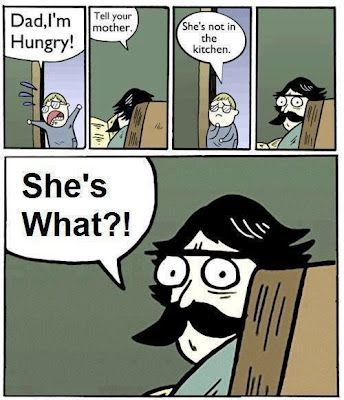Is it just me or does every semester
seem to go by faster and faster? I cannot believe this is my last
post and I have to admit, I'm kind of going to miss blogging.
However, it is pretty time consuming to think of an idea, do some
research, and then (thoughtfully) write.
For my last entry, *sniffle*
I'm going to talk about traditional gender roles. It will be somewhat
difficult to keep this post around the correct length because these
issues are what sparked my interest in taking a gender course in the
first place. In other words, I feel like I could babble on and on
forever. This idea of men working to be the breadwinner of the family
and women belonging only in the kitchen has long since died. Since
the economic downturn and a priority for a higher standard of living,
more and more couples are now equally employed in order to support a
family.
My main argument is: “Funny
pictures” tend to reinforce very traditional gender stereotypes, and are
not healthy in the time of nearing gender equality. I went to the
facebook page “No Hope for the Human Race” and found some
material to support my claim. Behold:
The above photo highlights two negative
things about male and female gender:
- Women are absurdly detail-oriented and slow in making decisions.Since women have absolutely nothing else to do but shop, cook, and take care of the kids, they have all the time in the world to think about the 12 characteristics of each beauty product they're buying. I'm pretty sure if a woman went through this many steps in order to buy one single product, it would take her days to go through a store and get to the checkout counter (I have a sarcastic attitude today, just in case you couldn't tell.) Though it is true women still currently have about 86% of the buying power in the United States, we are getting closer to an era of equality among women and men dividing the shopping, household chores, and childcare (gendered division of labor.)
- Men make fast decisions [because they don't care about hygiene.]Men do not value the way they look enough to care about which brand of shampoo they purchase. The photo also reinforces the stereotype of men as bread-winners who thus have better things to do than to be wasting time picking out shampoo.On a side note, though some men may not have a preference, I care about which shampoo I buy. I've been using this shampoo for a couple years now and I like it a lot. It's a great brand, love the way it smells. You can get it for around $6-7 at Target.
I just wanted to mention a couple
things about the following pictures, since this is already starting
to get lengthy...
The above photo almost killed me. The
picture is two-fold. The general theme is: a woman's only role in
life is to take care of a man. It provides two implications. EITHER
women use a flat-iron to cook bacon instead
of a stove or a microwave because they're THAT incompetent. OR women are so infatuated with the way
they look, they can't even get out of the bathroom long enough to
make their husband/significant other bacon in the morning.
Again, the same theme:
Moral of the story is...
Ladies: If you're still scrubbing the
kitchen floors on your hands and knees while your other half drinks
beer and works on petty projects in the garage with his buddies all
weekend, you're only contributing to gender inequality.
Men: Start caring more. Start cooking
dinner sometimes. Step up. It won't be long before women just swear
us off altogether and we become only needed for reproduction. I'm
half kidding – half not.
I figured I might as well go out with a
bang and incorporate a little bit of my humor into my final post;
hope I didn't make it too sassy. At any rate, thank you for visiting
throughout the semester! I hope you've enjoyed my blog and have at
least learned something from it. Happy Gendering! :)














